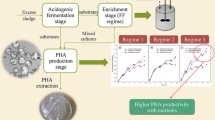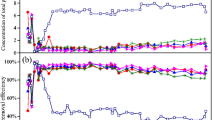Abstract
In this paper, a study was conducted on the effect of polyhydroxyalkanoates (PHA) and glycogen transformations on biologic nitrogen and phosphorus removal in low dissolved oxygen (DO) systems. Two laboratory-scale sequencing batch reactors (SBR1 and SBR2) were operating with anaerobic/aerobic (low DO, 0.15–0.45 mg·L−1) configurations, which cultured a propionic to acetic acid ratio (molar carbon ratio) of 1.0 and 2.0, respectively. Fewer poly-3-hydroxybutyrate (PHB), total PHA, and glycogen transformations were observed with the increase of propionic/acetic acid, along with more poly-3-hydroxyvalerate (PHV) and poly-3-hydroxy-2-methyvalerate (PH2MV) shifts. The total nitrogen (TN) removal efficiency was 68% and 82% in SBR1 and SBR2, respectively. In the two SBRs, the soluble ortho-phosphate (SOP) removal efficiency was 94% and 99%, and the average sludge polyphosphate (poly-P) content (g·g-MLVSS−1) was 8.3% and 10.2%, respectively. Thus, the propionic to acetic acid ratio of the influent greatly influenced the PHA form and quantity, glycogen transformation, and poly-P contained in activated sludge and further determined TN and SOP removal efficiency. Moreover, significant correlations between the SOP removal rate and the (PHV + PH2MV)/PHA ratio were observed (R 2>0.99). Accordingly, PHA and glycogen transformations should be taken into account as key components for optimizing anaerobic/aerobic (low DO) biologic nitrogen and phosphorus removal systems.
Similar content being viewed by others
References
Metcalf X, Eddy X. Wastewater Engineering: Treatment, Disposal and Reuse, 3ed. McGraw-Hill, New York, 1991, 429–433
Obaja D, Macé S, Mata-Alvarez J. Biological nutrient removal by a sequencing batch reactor (SBR) using an internal organic carbon source in digested piggery wastewater. Bioresource Technology, 2005, 96(1): 7–14
Tanwar P, Nandy T, Khan R, Biswas R. Intermittent cyclic process for enhanced biological nutrient removal treating combined chemical laboratory wastewater. Bioresource Technology, 2007, 98(13): 2473–2478
Comeau Y, Hall K, Hancock R, Oldham W. Biochemical model for enhanced biological phosphorus removal. Water Research, 1986, 20(12): 1511–1521
Bertanza G. Simultaneous nitrification-denitrification process in extended aeration plants: Pilot and real scale experiences. Water Science and Technology, 1997, 35(6): 53–61
Helmer C, Kunst S. Simultaneous nitrification/denitrification in an aerobic biofilm system. Water Science and Technology, 1998, 37(4–5): 183–187
Zeng R J, Saunders A M, Yuan Z, Blackall L L, Keller J. Identification and comparison of aerobic and denitrifying polyphosphate-accumulating organisms. Biotechnology and Bioengineering, 2003a, 83(2): 140–148
Zeng R J, Lemaire R, Yuan Z, Keller J. Simultaneous nitrification, denitrification, and phosphorus removal in a lab-scale sequencing batch reactor. Biotechnology and Bioengineering, 2003b, 84(2): 170–178
Meyer R L, Zeng R J, Giugliano V, Blackall L L. Challenges for simultaneous nitrification, denitrification, and phosphorus removal in microbial aggregates: Mass transfer limitation and nitrous oxide production. FEMS Microbiology Ecology, 2005, 52(3): 329–338
Lemaire R, Meyer R, Taske A, Crocetti G R, Keller J, Yuan Z. Identifying causes for N2O accumulation in a lab-scale sequencing batch reactor performing simultaneous nitrification, denitrification and phosphorus removal. Journal of Biotechnology, 2006, 122(1): 62–72
Von Müch E. DSP prefermenter technology book. Bresbane Old, Australia: Science Traveller International CRC WMPC Ltd, 1998
Naik R V. Enhancement of denitrification using prefermenters in biological nutrient removal systems. Orlando, FL: University of Central Florida, 1999
Abu-ghararah Z H, Randall C W. A proposed model for the anaerobic metabolism of short-chain fatty acids in enhanced biological phosphorus removal systems. Research Journal WPCF, 1989, 61: 1729–1730
Satoh H, Mino T, Matsuo T. Uptake of organic substrates and accumulation of ployhydroxyalkanoates linked with glycolysis of intracellular carbohydrates under anaerobic conditions in the biological excess phosphate removal process. Water Science and Technology, 1992, 26(5–6): 933–942
Hood C R, Randall A A. A biochemical hypothesis explaining the response of enhanced biological phosphorus removal biomass to organic substrates. Water Research, 2001, 35(11): 2758–2766
Randall A A, Liu Y. Polyhydroxyalkanoates form potentially a key aspect of aerobic phosphorus uptake in enhanced biological phosphorus removal. Water Research, 2002, 36(14): 3473–3478
Pijuan M, Saunders A M, Guisasola A A, Baeza J A, Casas C, Blackall L L. Enhanced biological phosphorus removal in a sequencing batch reactor using propionate as the sole carbon source. Biotechnology and Bioengineering, 2004, 85(1): 56–67
Chen Y, Chen Y S, Xu Q, Zhou Q, Gu G. Comparison between acclimated and unacclimated biomass affecting anaerobic-aerobic transformations in the biological removal of phosphorus. Process Biochemistry (Barking, London, England), 2005, 40(2): 723–732
Chuang S H, Ouyang C F, Yuang H C, You S J. Phosphorus and polyhydroxyalkanoates variation in a combined process with activated sludge and biofilm. Water Science and Technology, 1998, 37(4–5): 593–597
Carvalho G, Lemos P C, Oehmen A, Reis M A M. Denitrifying phosphorus removal: Linking the process performance with the microbial community structure. Water Research, 2007, 41(19): 4383–4396
Mino T, Arun V, Tsuzuki Y, Matsuo T. Effect of phosphorus accumulation on acetate metabolism in the biological phosphorus removal process. In: Ramadori R, ed.. Biological Phosphate Removal from Wastewaters, Pergamon Press, Oxford, UK, 1987, 27–38
Chen Y, Liu Y, Zhou Q, Gu G. Enhanced phosphorus biological removal from wastewater-effect of microorganism acclimatization with different ratios of short-chain fatty acids mixture. Biochemical Engineering Journal, 2005, 27(1): 24–32
Zhou Y, Pijuan M, Zeng R J, Lu H, Yuan Z. Could polyphosphateaccumulating organisms (PAOs) be glycogen-accumulating organisms (GAOs)? Water Research, 2008, 42(10–11): 2361–2368
Comeau Y, Hall K J, Oldham W K. Determination of poly-β-hydroxybutylate and poly-β-hydroxyvalerate in activated sludge by gas-liquid chromatography. Applied and Environment Microbiology, 1988, 54(9): 2325–2327
Oehmen A, Keller-Lehmann B, Zeng R J, Yuan Z, Keller J. Optimisation of poly-β-hydroxyalkanoate analysis using gas chromatography for enhanced biological phosphorus removal systems. Journal of Chromatography A, 2005, 1070(1–2): 131–136
Jenkins D, Richard M G, Daigger G T. Manual on the causes and control of activated sludge bulking and foaming. 2nd edition. Florida: Lewis Publishers, 1993
APHA. Standard Methods for the Examination of Water and Wastewater. Washington D C: American Public Health Association, 1998
Lemos P C, Viana C, Salgueiro E N, Ramos A M, Crespo J P S G, Reis A M. Effect of carbon source on the formation of polyhydroxyalkanotes (PHA) by a phosphate-accumulating mixed culture. Enzyme and Microbial Technology, 1998, 22(8): 662–671
Broughton A, Pratt S, Shilton A. Enhanced biological phosphorus removal for high-strength wastewater with a low rbCOD:P ratio. Bioresource Technology, 2008, 99(5): 1236–1241
Oehmen A, Saunders A M, Vives M T, Yuan Z, Keller J. Competition between polyphosphate and glycogen accumulating organisms in enhanced biological phosphorus removal systems with acetate and propionate as carbon sources. Journal of Biotechnology, 2006, 123(1): 22–32
Schuler A J, Jenkins D. Enhanced biological phosphorus removal from wastewater by biomass with different phosphorus contents, Part I: Experimental results and comparison with metabolic models. Water Environment Research, 2003, 75(6): 485–498
Liu W T, Nakamura K, Matsuo T, Mino T. Internal energy-based competition between polyphosphate-and glycogen-accumulating bacteria in biological phosphorus removal reactors-effect of P/C feeding ratio. Water Research, 1997, 31(6): 1430–1438
Chen Y, Randall A A, Mccue T. The efficiency of enhanced biological phosphorus removal from real wastewater affected by different ratios of acetic to propionic acid. Water Research, 2004, 38(1): 27–36
Thomas M, Wright P, Blackall L L, Urbain V, Keller J. Optimisation of Noosa BNR plant to improve performance and reduce operating costs. Water Science and Technology, 2003, 47(12): 141–148
Randall A A, Chen Y, Liu Y H, McCue T. Polyhydroxyalkanoate form and polyphosphate regulation: Keys to biological phosphorus and glycogen transformations? Water Science and Technology, 2003, 47(11): 227–233
Author information
Authors and Affiliations
Corresponding author
Rights and permissions
About this article
Cite this article
Li, H., Chen, Y. Research on polyhydroxyalkanoates and glycogen transformations: Key aspects to biologic nitrogen and phosphorus removal in low dissolved oxygen systems. Front. Environ. Sci. Eng. China 5, 283–290 (2011). https://doi.org/10.1007/s11783-010-0243-9
Received:
Accepted:
Published:
Issue Date:
DOI: https://doi.org/10.1007/s11783-010-0243-9




